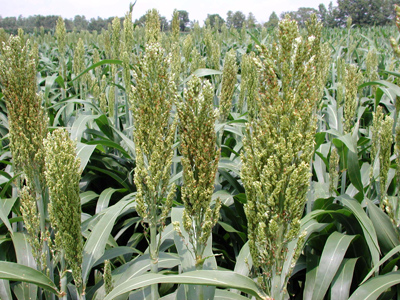
- General Management
- Insect Pests
- Soil and Seedling Pests
- Leaf and Stalk-Boring Pests
- Panicle and Seed Pests
- Birds
- Beneficial Insects
Insect pests can be a major limiting factor in grain sorghum production in Georgia. Growers must be prepared to scout and prevent injury from insects. However, a proper insect pest management program will minimize losses to insects and ensure appropriate insecticide use. This publication provides information on the biology and management of sorghum pests. Specific insecticide recommendations are updated annually and are available in the Georgia Pest Management Handbook, Commercial Edition.
Grain sorghum is relatively tolerant to insect feeding. Higher seeding rates and ability to tiller make stand losses to soils insect less severe than in corn. Likewise, sorghum is very tolerant of defoliation. However, insects that prevent seed set or cause direct damage to seed can produce serious loss, because the crop does not have time to compensate by producing new florets and setting seed. The crop's inherent tolerance of injury means treatment thresholds are usually high. But recent strong commodity prices for sorghum justify monitoring for insect pests and use of insecticides when pest populations exceed treatment thresholds.
General Management
Rotate crops. Rotation will help minimize the buildup of sorghum pests in the same field.
Select proper hybrids. Plant well-adapted, vigorous, high-yielding hybrids with good disease resistance and standability.
Maintain fertility. Test soil and apply fertilizer and lime according to the University of Georgia Cooperative Extension recommendations to maintain the proper soil fertility.
Plant early (when possible). Sorghum planted in early May in south Georgia and by the middle of May in north Georgia often escapes major insect damage. Several sorghum pests, such as sorghum midge, do not usually reach damaging population levels until after early plantings are mature.
In conventional-tillage, bury previous-crop residue (especially sod) and keep free of weeds (especially grasses) for at least 2 weeks before planting. This practice helps reduce the incidence of damage from insects, which may establish infestations on weeds, volunteer grasses or grass sod. Also, cutworms are often a problem where previous-crop residue is present on the soil surface at planting.
Timely harvest helps to prevent seed damage by pests and birds.
Insect Pests
Important pests of grain sorghum in the southern United States include the sorghum midge, lesser cornstalk borer, soil insects, fall armyworm, aphids, headworms (mainly corn earworm and sorghum webworm), chinch bugs, and stink bugs.
 Figure 1. Wireworm.
Figure 1. Wireworm.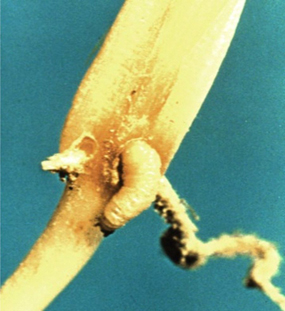 Figure 2. Rootworm.
Figure 2. Rootworm.Soil and Seedling Pests
Soil insects that attack sorghum include wireworms, white grubs, whitefringed beetle larvae, seedcorn maggots, southern corn rootworm, and lesser cornstalk borer. Soil insects are difficult to sample and predict. Before planting, inspect soil carefully when preparing land for planting (especially when turning land) for the presence of white grubs, wireworm or whitefringed beetle larvae. Since these insects will go back to the soil within seconds, make inspections immediately after turning the soil. Soil insects will destroy seed causing gaps in the stand. They also can bore into seedling plants below the soil surface killing the main stem, which kills the leaf whorl causing a "deadheart" type injury.
The following conditions increase the risk of damage by soil insects:
- Reduced, strip-till, and no-till systems where previous crop residue remains on the soil surface. Cool, wet conditions favor wireworms, grubs, and cutworms.
- Planting into sod or following newly tilled ground previously in sod or weedy species.
- Planting late such as doublecropping behind winter crops or vegetables.
- Doublecropping behind cereal grains or winter cover crops. Cereal crops and sorghum are both grasses and are often attacked by the same insects.
- Planting into burnt cereal stubble and/or planting under conventional tillage on light soils during hot, droughty conditions. This favors lesser cornstalk borer infestations.
Sorghum can tolerate some stand loss without affecting yield. The higher seeding rates allow sorghum to withstand up to 15 percent stand loss. However, soil insect damage often is not uniform and is concentrated in certain areas. Losses in those spots can be severe.
Soil insecticides are not routinely used at planting in grain sorghum. However, if one or more of the above conditions exist, it is appropriate to consider the use of an at-planting insecticide or seed treatment. The best way to apply an at-planting granular insecticide on grain sorghum (where the label allows) is in a narrow band over the row behind the planter shoe and in front of the press wheel. This method of application concentrates some of the material in a band near the surface of the soil where insects are more likely to come in contact with it. New systemic insecticide seed treatments, such as Gaucho™ and Cruiser™, provide control of most soil insects while also systemically protecting the seedling for the first few weeks (20–25 days) after planting. Seed treatments usually must be applied to seed by specialized seed treatment equipment but do not require specialized application equipment on planters. They also have better worker safety than older organophosate insecticides.
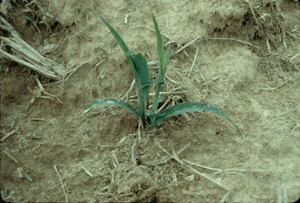 Figure 3. Damaged seedling with suckers.
Figure 3. Damaged seedling with suckers.Several different insects can attack, damage and kill seedlings. Insect feeding will kill the plant or destroy the primary tiller causing the plant to produce secondary tillers or suckers. These pests include:
Lesser cornstalk borer (Elasmoplapus lignosellus) is a moth. Larvae feed below the soil line where they bore into the stem base often killing the main growing point. Larvae are blue-green with transverse brown bands. LSCB is easily identified because larvae are usually enclosed in a silken tube, which has incorporated soil particles. LCSB is favored by conventional tillage under hot, dry conditions, sandy soils, doublecropping behind cereal grains, and planting into burnt cereal grain stubble. Preventive insecticides, such as systemic seed treatments or chlorpyrifos 15G applied at planting in a band over the row, best control LCSB. Rescue treatments, once damage is detected, are not effective.
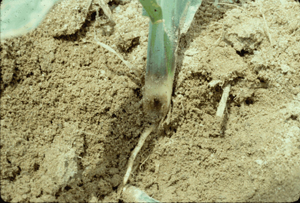 Figure 4. Insect feeding destroying main stem.
Figure 4. Insect feeding destroying main stem.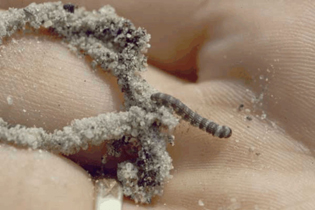 Figure 5. LCSB larva.
Figure 5. LCSB larva.
Billbugs (Sphenophorus spp.) are medium brown to blackish beetles with a distinct beak typical of weevils. Adults chew holes in the stem base usually at of near the soil line. Infestations often are associated with nut sedge, which is the only significant alternate host. Billbugs normally crawl from field to field, and infestations often occur annually in the same field. Consequently, crop rotation can be effective at controlling this pest.
Preventive treatment is most effective using systemic seed treatments or at-planting insecticides, but rescue treatments are rarely effective.
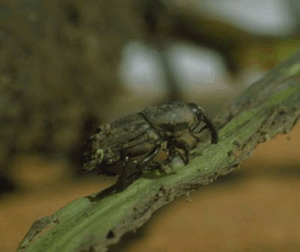 Figure 6. Billbug.
Figure 6. Billbug.
Sugarcane beetle (Euetheola humilis rugiceps) is a black scarab beetle that chews a hole in the stem usually at or near ground level. This beetle can attack seedling and older stage plants. It is often associated with infestation of bahiagrass, which is a preferred alternate host.
Preventive treatment is most effective using systemic seed treatments or at-planting insecticides, but rescue treatments are rarely effective.
 Figure 7. Sugarcane beetle.
Figure 7. Sugarcane beetle.
Cutworms (several species) are larvae of moths. Several species may attack sorghum. Typically they remain in the soil and feed at night where they cut off seedling plants at or near ground level. Plants cut above the main growing point may regrow. Heavy infestations usually kill the main stem or completely destroy plants. Risk of cutworm damage is greater in reduced tillage systems. Control weeds several weeks before planting. Cutworms can be controlled preventively using at-planting soil insecticides or by pre-plant, at-planting or post at-planting or postemergence foliar sprays. Spay in a band over the row. Cutworm rescue treatments using a foliar-applied insecticide may be useful.
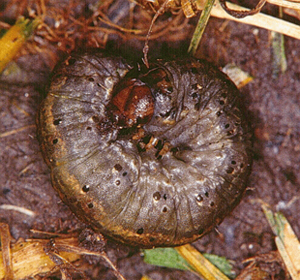 Figure 8. Cutworm.
Figure 8. Cutworm.Chinch bug (Blissus leucopterus leucopterus) can infest sorghum at any stage, but is most damaging during the seedling and early vegetative stages. Adults are about c-inch long, black with a white to silver X marking on the back. Nymphs are reddish brown when small, becoming dark gray just before adulthood. Nymphs also have a white stripe across the back.
Chinch bugs suck plant sap and feed mostly on the stem and large leaf veins. Their feeding causes red/ yellow leaf discoloration, wilting and stunted growth. Large numbers can kill seedlings. During grain filling large infestations can kill leaves hastening plant senescence. Chinch bugs move from nearby cereal grain fields to invade sorghum fields in spring and early summer. In this situation chinch bugs usually will concentrate along field margins or in one area of a field. They also may reside on grassy weeds in reduced tillage and move to seedling plants as they emerge.
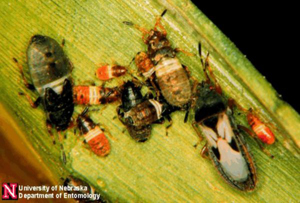 Figure 9. Chinch bug nymphs and adult.
Figure 9. Chinch bug nymphs and adult.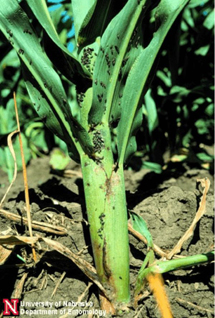 Figure 10. Chinch bugs on sorghum stalk.
Figure 10. Chinch bugs on sorghum stalk.
Chinch bugs prefer hot dry conditions. Cool, wet conditions and heavy rain usually promote a fungal pathogen that can cause substantial mortality and therefore chinch bugs are not a problem under these conditions.
When to treat: In seedlings, treat when two or more adults are found on 20 percent of seedlings. On taller plants up to 6 inches, treat when 75 percent of plants are infested OR five or more chinch bugs per plant are present. Chinch bugs usually reside at the base of plants and under the leaf sheath. Consequently, postemergence applications should be directed at the base of plants using enough final spray and pressure to ensure good coverage. Getting good spray coverage becomes more difficult in larger plants. Treatments after the boot stage rarely are effective. At-planting applications and systemic seed treatments may provide seedling control for 20-25 days.
Leaf and Stalk-Boring Pests
Aphids and Greenbug
Several species of aphids can attack sorghum. Aphids are small soft-bodied insect that have sucking mouthparts and feed on plant sap. Predominant aphids attacking sorghum in Georgia are the corn leaf aphid, Rhopalosiphum maidis, and the greenbug, Shizaphis graminim. Yellow sugarcane aphid, Sipha flava, also occasionally is a pest in Georgia, but is more prevalent in southern Alabama. Corn leaf aphids are blue greenish with black legs and antennae. Corn leaf aphid feeding can reduce plant growth by removing sap but is not toxic to the plants. Consequently sorghum can support large corn leaf aphid infestations without much damage. Greenbug are medium green with a distinct dark green stripe down the back. Yellow sugarcane aphids, are yellow with small black dots. Feeding by greenbugs and yellow sugarcane aphids causes a toxic reaction in the plant causing brown lesions. Large infestations can stunt and kill leaves and whole plants.
Aphids also secrete a sugary solution called honeydew. A black fungus called sooty mold can grow on the honeydew. The fungus does not directly harm the plant but blocks sunlight from contaminated leaves and can discolor developing seeds.
When to treat: Aphids seldom require control in Georgia. Usually natural enemies such as lady beetles, hover fly larvae, parasitic wasps and others will control aphid infestations. However if aphids, especially greenbug and yellow sugarcane aphid, persist and are discoloring and stunting seedlings, an insecticide treatment may be needed. In larger plants, an insecticide treatment may be needed if aphids are causing the discoloration and death of two or more leaves. Systemic seed treatments normally are not justified specifically for aphid control, but if used they will control aphids for about 20 days after planting.
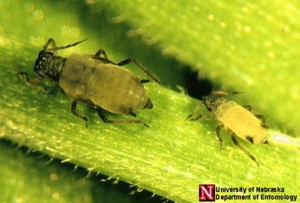 Figure 11. Corn leaf aphids.
Figure 11. Corn leaf aphids.Whorl-Worms, Budworms, Fall Armyworm in Whorls
Fall armyworm (Spodoptera frugiperda) is the most common caterpillar feeding in the whorls of sorghum. True armyworm (Pseudaletia unipuncta), corn earworm (Helicoverpa zea) and other armyworms (Spodoptera spp.) also may infest whorls. Fall armyworm moths lay egg masses on the plants. Small larvae will feed on leaves causing windowpane type feeding before moving into the leaf whorl. There they will feed until full size when they leave the whorl and pupate in the soil. Larvae are variable in color, usually are dark with a cream to white inverted Y on its head, three white lines along the body, and 4 dots in a nearly square pattern on the top of the last abdominal segment. Larvae can reach 1.5 inches long.
When fall armyworms feed in the whorl they are called budworms or whorl-worms. Feeding can cause large irregular holes in leaves as they unroll from the whorl. Sometimes the main vein is cut causing the entire leaf tip to die. Fall armyworm populations increase as the season progresses. This is why late planted or doublecropped sorghum is at greater risk of defoliation than early-planted sorghum.
When to treat: Sorghum is very tolerant of defoliation. Insecticide control seldom is justified. Consider treatment when 40 percent or more of the whorls are being damaged and larvae are present, OR one or more worms per whorl are present. To obtain effective control, spray applications should be applied by ground equipment using enough gallonage and pressure to place spray down into the whorls.
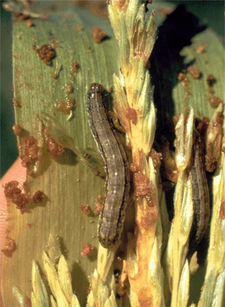 Figure 12. Fall armyworms.
Figure 12. Fall armyworms.Grasshoppers
Nymphs and adults of several species of grasshopper may chew holes in leaves causing a ragged appearance in sorghum. Grasshoppers can buildup in field border areas and move into sorghum fields, consequently damage often is concentrated along field margins. Grasshopper populations usually are greater in dry than wet years.
When to treat: Consider an insecticide treatment when eight nymphs per square yard are present and damage is evident. Sometimes only a border treatment of the first 50-100 feet may be needed if grasshoppers are concentrated in the field margin.
Mites
Spider mites (usually Tetranychus urticae) occasionally damage sorghum in the Southeast. Mites are very small arachnids; adults have eight legs and larvae have six legs. Spider mites suck plant fluids from the lower leaf surface. They inhabit webbing usually on the lower leaf surface. Feeding causes leaf wilting and chlorosis (discoloration) as their feeding destroys plant cells. Mites prefer hot, dry conditions.
When to treat: Mites seldom require control in Georgia. Treat if infestations are present and leaf discoloration is apparent. Chemical treatments after the boot stage are rarely effective and not recommended.
European Corn Borer and Other Stalk Borers
Several stalk boring moth caterpillars that attack corn, including European corn borer, Ostrinia nubilalis; southwestern corn borer, Diatraea grandiosella and others, also may infest sorghum. In areas where sugarcane is grown such as the southernmost counties of Alabama, sugarcane borer, Diatraea saccharalis, may attack nearby sorghum fields.
These moths lay eggs in masses on plants. Small larvae feeding on leaves cause shot-hole defoliation before tunneling into the stalk. Larger larvae tunnel in stalks causing reduced grain fill and increased stalk lodging. Stalk borer damage also may make plants more susceptible to stalk rot diseases.
European corn borer has two distinct generations in Georgia. First-generation larvae bore into whorl leaves and sheaths, while second-generation larvae bore into the main stalk. Later plantings are at greatest risk of damage. These moths overwinter as large larvae in crop stubble. Disking or shredding stalks will help reduce winter survival and populations the following year.
When to treat: European corn borer and other stalk borers rarely cause damage to sorghum in Georgia. To be effective, insecticides must be applied to kill larvae before they tunnel into stalks. Treatment may be warranted if egg masses are numerous and/or newly hatched larvae are causing shot hole damage on 25 percent or more of plants. However, foliar applied treatments are only at best 50 percent effective. Because of the cost of sampling, infrequent infestations and difficulty of timing treatments, chemical control is rarely justified.
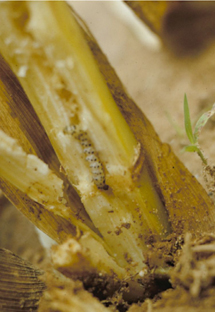 Figure 13. Southwestern cornstalk borer tunneling in a sorghum stalk.
Figure 13. Southwestern cornstalk borer tunneling in a sorghum stalk.Panicle and Seed Pests
Sorghum Midge
Sorghum midge (Stenodiplosis sorghicola) has the potential to be a devastating pest of sorghum in Georgia. The adult is a tiny, fragile-looking, orange colored gnat-like fly. Females lay eggs singly in sorghum flowers during pollination.The larva is an orange maggot that feeds on the developing seed. When larvae are full size they pupate within the flower. The pupa pushes its way to out and adults emerge, leaving the pupal case protruding from glumes. The florets have a "blasted" appearance. The entire life cycle can take as few as 14 days.
Sorghum and johnsongrass are the only hosts of sorghum midge. Sorghum midge populations can build up on johnsongrass before sorghum planting. Sorghum midge also will increase throughout the season on successive plantings of sorghum. Consequently, late-planted sorghum is at increased risk of sorghum midge damage.
Control of sorghum midge requires control of egg-laying adults. Timing of control is critical because maturing adults occur in the morning. Sampling and spray(s) need to be applied at that time for effective control. Sample fields when plants reach 20 percent bloom and continue sampling every few days until 90 percent bloom. The most efficient technique is to carefully inspect sorghum panicles (heads) for adults. Sample at least 20 panicles for each 8 acres of field. Panicles also can be shaken into a plastic bag and the contents inspected for midges.
Management tactics for sorghum midge include crop rotation, early planting, controlled seed depth so that plants emerge uniformly and fields flower at the same time, controlling johnsongrass, and plowing to bury overwintering larvae to reduce midge emergence the next season. Plant resistance has been identified that reduces damage by about 80 percent. Resistance, however, is not currently available in commercial hybrids grown in this area.
When to treat: The treatment threshold for sorghum midge is one adult per panicle (head) when 20 - 30% of panicles are in bloom. Re-inspect the field within a few days to verify control. A second application 5 to 10 days later may be needed for effective control. When the economic threshold is reached, spray immediately; delay of a day or two can result in serious damage. The susceptible period for midge is during bloom; treatment after bloom is too late. Larvae cannot be controlled once eggs are laid in the flower. Most labeled insecticides are effective against sorghum midge at the lowest labeled rate.
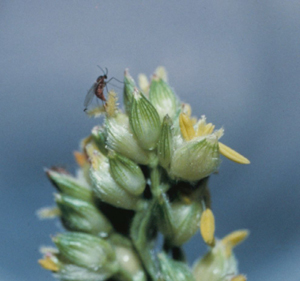 Figure 14. Sorghum midge on sorghum panicle.
Figure 14. Sorghum midge on sorghum panicle.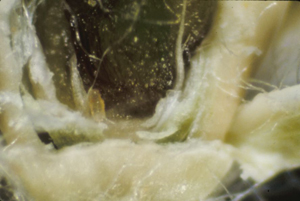 Figure 15. Sorghum midge larva in sorghum flower.
Figure 15. Sorghum midge larva in sorghum flower.
Headworms (Corn Earworms, Fall Armyworms, Sorghum Webworms)
Headworms usually are a mixture of several species of caterpillars. The main species are corn earworm (H. zea), fall armyworm (S. frugiperda) and sorghum webworm (Nola sorghiella). Larvae of these moths feed on flowers and developing seed, where they partly or completely consume seed. In most years, the corn earworm is the most important species partly because its large size allows it to consume a lot of seed. Fall armyworm can also cause considerable damage during outbreak years.
Corn earworms are greenish to brownish with a yellowish head and true legs. Fall armyworms are darker with a distinct inverted white Y on their heads, three white lines along the body, and four dots in a nearly square pattern on the top of the last abdominal segment. Sorghum webworms are smaller than the other two, flattened, yellow-greenish with four lengthwise dark stripes. Mature webworms are covered with hair that can be irritating to some people. Corn earworms and armyworms occur individually on panicles. Sorghum webworms often are clumped on one or a few panicles. Because headworms are exposed on the heads, they are attacked by numerous parasites and predators including birds. Under the right environmental conditions, large infestations of headworms also can be decimated by several insect diseases.
These insects have several generations per year and populations increase throughout the season. Consequently, the risk of head worm damage greatly increases in later plantings. After sorghum begins to bloom, inspect field once or twice a week. Sample by shaking heads over a bucket or sweep net and counting larvae. Sample 30-50 panicles (heads) per field.
When to treat: Treat when a total of two or more larvae (1/2 inch or longer) of corn earworm and fall armyworm occur per head. Treat if four or more webworms per head are found. Pyrethroid insecticides may not be effective against sorghum webworms.
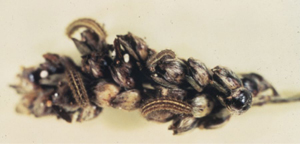 Figure 16. Sorghum webworms on sorghum panicle.
Figure 16. Sorghum webworms on sorghum panicle.Stink Bugs
Sorghum seed is readily attacked by several species of stink bugs and related insects. Common stink bugs in sorghum include the southern green stink bug (Nezera viridula), brown stink bug (several species of Euschistus spp.), and rice stink bug (Oebalus pugnax). A related insect, the leaf-footed bug (Leptoglossus phyllopus), also causes the same type of injury. Leaf-footed bug is large about 1 inch long, brown with a thin white stripe across the back. Their hind legs are dilated and flattened and resemble a leaf.
Stink bugs usually move into sorghum soon after flowering. They lay barrel-shaped eggs in clusters. Nymphs will develop and typically complete development before sorghum maturity. Stink bugs have sucking mouthparts and feed on developing seed within the panicle. Their feeding will shrivel seed thereby reducing seed size and quality. They also may feed on stems and other plant parts but the main damage is from kernel (seed) feeding. Sorghum is most susceptible during the milk and soft dough stage. Injury normally is not damaging from hard dough to maturity.
Stink bugs can be sampled using the same techniques described for headworms. Sample by beating or shaking panicles over a sweep net or bucket and counting the bugs that appear. Sample 30-50 panicles per field.
When to treat: Treat if combined numbers of all stink bugs (large nymphs and adults) exceeds two bugs per head during milk stage or four bugs per head during soft dough stage. Insecticides recommended for stink bug control also will control headworms. However, some of the insecticides recommended for headworms such as spinosad (Tracer(TM)) are not effective against stink bugs.
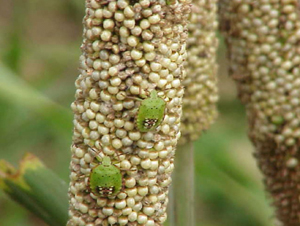 Figure 17. Southern green stink bug nymphs on pearl millet.
Figure 17. Southern green stink bug nymphs on pearl millet. Figure 18. Leaf-footed bug on sorghum panicle.
Figure 18. Leaf-footed bug on sorghum panicle.
False Chinch Bugs
False chinch bugs are related to true chinch bugs, but are a uniformly medium gray. False chinch bugs can occur in large numbers during grain filling. They suck plant fluids and can injure developing seed. Their small size, ¼ inch, means large numbers are needed to damage sorghum. Scout using the same techniques described for stink bugs and headworms. Infestations usually are concentrated in one area of a field.
When to treat: Treat if populations exceed 100 bugs per head during milk to early soft dough stage. False chinch bugs rarely require control by themselves, but should be considered in combination with stink bugs and headworms.
Birds
Several types of birds including blackbirds can infest grain sorghum during the period of hard dough to maturity, where they perch on panicles and eat seed. Birds will consume whole seed but also will break seed by eating portions and leaving half of the seed on the panicle. This damage is easily recognized because of the clean break and exposed white endosperm of the seed. Birds also will defecate while feeding, and their droppings and feathers are readily apparent on the panicles and upper leaves.
Small fields surrounded by woods and fields with structures such as power lines and irrigation equipment provide birds a place to perch and congregate when not feeding. Late-planted fields with maturing grain in the fall, when birds start swarming, also are at increased risk of bird damage. Birds quickly learn the location of fields when sorghum is planted year after year in the same location.
There are no legal chemical methods for bird control. Bird distress callers, blank shooters, and various types of reflective plates and tinsel may scare off birds. Timely harvest will help reduce the potential for bird damage.
Beneficial Insects
Several types of beneficial arthropods commonly occur in sorghum. They will help control pest species. Correct identification is important so that beneficials are not mistaken as pests. Beneficial insects in grain sorghum generally are the same species as those in other field crops. Common beneficial arthropods include the following: lady beetles, syrphid or hover fly larvae, big-eyed bugs, damsel bugs, minute pirate bug, lacewings, ground beetles, spiders and numerous parasitic wasps and flies.
Visit this website to read descriptions and view photos of many natural enemies that may be found in sorghum (https://extension.uga.edu/programs-services/landscape-pest-management/beneficial-insects.html).
Status and Revision History
Published on Mar 16, 2009
Published with Minor Revisions on Mar 13, 2012
Published with Minor Revisions on Nov 30, 2024


























































